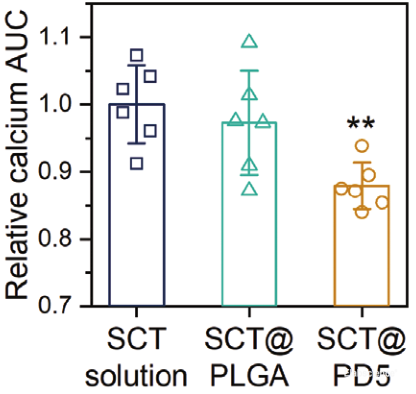Calcium (Ca) Colorimetric Assay Kit
SKU: E-BC-K103-M-500
Calcium (Ca) Colorimetric Assay Kit
| SKU # | E-BC-K103-M |
| Detection Instrument | Microplate reader (600-620 nm, optimum wavelength: 610 nm) |
| Detection Method | Colorimetric method |
Product Details
Properties
| Synonyms | Ca |
| Sample Type | Serum, plasma, urine, tissue |
| Sensitivity | 0.07 mmol/L |
| Detection Range | 1.5-150 mmol/L |
| Detection Method | Colorimetric method |
| Assay type | Quantitative |
| Assay time | 20 min |
| Precision | Average inter-assay CV: 8.500% | Average intra-assay CV: 4.700% |
| Other instruments required | Micropipettor, Centrifuge, Incubator, Vortex mixer |
| Storage | 2-8℃ |
| Valid period | 12 months |
Images
TH Huang et al developed a surface decorated peptide nanoparticle that can be used for osteoporosis and diabetes therapy. Calcium (Ca) level in rat plasma was determined using Ca colorimetric assay kit (E-BC-K103-M).

The levels of Ca concentration was significantly reduced in PD5 group. (**P<0.01)
Dilution of Sample
It is recommended to take 2~3 samples with expected large difference to do pre-experiment before formal experiment and dilute the sample according to the result of the pre-experiment and the detection range (0.07-1.2 mmol/L).
The recommended dilution factor for different samples is as follows (for reference only):
| Sample type | Dilution factor |
| Dog serum | 2-3 |
| Human serum | 3-6 |
| Mouse serum | 3-6 |
| Human urine | 4-8 |
| 20% Animal tissue homogenate | 1 |
Note: The diluent is deionized water.
Detection Principle
Calcium ion in the sample bind to Methyl Thymol Blue (MTB) in alkaline solution and form blue complex. The blue complex has a specific absorption peak at 715nm and calcium content can be calculated by measuring the OD value at 610 nm.
Kit Components & Storage
| Item | Component | Size 1(48 T) | Size 2(96 T) | Storage |
| Reagent 1 | MTB Reagent | 5 mL ×1 vial | 10 mL ×1 vial | 2-8°C, 12 months, shading light |
| Reagent 2 | Alkali Reagent | 10 mL ×1 vial | 20 mL × 1 vial | 2-8°C, 12 months |
| Reagent 3 | Clarificant | 1 mL ×1 vial | 1 mL ×1 vial | 2-8°C, 12 months |
| Reagent 4 | 2.5 mmol/L Calcium Standard | 5 mL ×1 vial | 10 mL ×1 vial | 2-8°C, 12 months |
| Microplate | 96 wells | No requirement | ||
| Plate Sealer | 2 pieces | |||
Note: The reagents must be stored strictly according to the preservation conditions in the above table. The reagents in different kits cannot be mixed with each other. For a small volume of reagents, please centrifuge before use, so as not to obtain sufficient amount of reagents.
Technical Data:
Parameter:
Intra-assay Precision
Three human serum samples were assayed in replicates of 20 to determine precision within an assay. (CV = Coefficient of Variation)
| Parameters | Sample 1 | Sample 2 | Sample 3 |
| Mean (mmol/L) | 0.35 | 0.86 | 1.05 |
| %CV | 4.8 | 4.7 | 4.6 |
Inter-assay Precision
Three human serum samples were assayed 20 times in duplicate by three operators to determine precision between assays.
| Parameters | Sample 1 | Sample 2 | Sample 3 |
| Mean (mmol/L) | 0.35 | 0.86 | 1.05 |
| %CV | 8.4 | 8.6 | 8.5 |
Recovery
Take three samples of high concentration, middle concentration and low concentration to test the samples of each concentration for 6 times parallelly to get the average recovery rate of 99%
| Standard 1 | Standard 2 | Standard 3 | |
| Expected Conc. (mmol/L) | 0.25 | 0.5 | 0.95 |
| Observed Conc. (mmol/L) | 0.3 | 0.5 | 0.9 |
| Recovery rate (%) | 101 | 99 | 97 |
Sensitivity
The analytical sensitivity of the assay is 0.07 mmol/L. This was determined by adding two standard deviations to the mean O.D. obtained when the zero standard was assayed 20 times, and calculating the corresponding concentration.
Standard Curve
As the OD value of the standard curve may vary according to the conditions of the actual assay performance (e.g. operator, pipetting technique or temperature effects), so the standard curve and data are provided as below for reference only:
| Concentration (mmol/L) | 0 | 0.2 | 0.3 | 0.4 | 0.6 | 0.8 | 1.0 | 1.2 |
| OD value | 0.225 | 0.246 | 0.265 | 0.273 | 0.297 | 0.321 | 0.348 | 0.365 |
| 0.227 | 0.242 | 0.255 | 0.275 | 0.297 | 0.323 | 0.344 | 0.369 | |
| Average OD | 0.226 | 0.244 | 0.260 | 0.274 | 0.297 | 0.322 | 0.346 | 0.367 |
| Absoluted OD | 0 | 0.018 | 0.034 | 0.047 | 0.071 | 0.096 | 0.120 | 0.141 |



